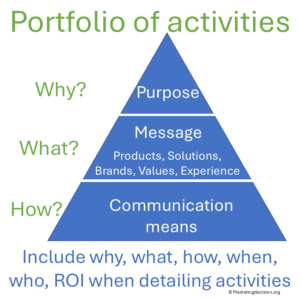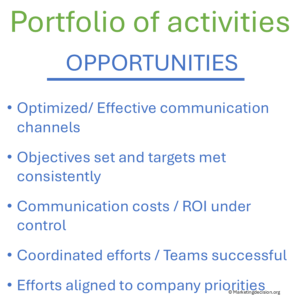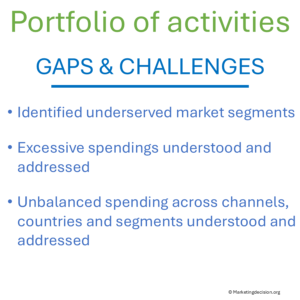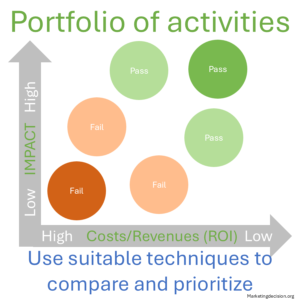 Companies often engage in numerous marketing initiatives through a variety of communication channels — including public relations (PR), direct online communication, promotional campaigns, and merchandising. Managing these initiatives effectively requires clarity and transparency.
Companies often engage in numerous marketing initiatives through a variety of communication channels — including public relations (PR), direct online communication, promotional campaigns, and merchandising. Managing these initiatives effectively requires clarity and transparency.
A well-structured promotion portfolio helps align promotional and communication programs with company objectives. It also brings visibility across departments, enabling teams to make confident budget decisions and better prepare for future investments.
Related reading: Purpose of Promotion
 One of the main challenges in promotion management is evaluating the effectiveness of communication channels, ensuring they reach the right audience, and deliver a positive Return on Investment (ROI).
One of the main challenges in promotion management is evaluating the effectiveness of communication channels, ensuring they reach the right audience, and deliver a positive Return on Investment (ROI).
To achieve this, companies must gain a comprehensive view of priorities across Marketing, Sales, Services, and other functions.
Developing a portfolio of promotional and communication activities helps identify where resources are best used — and where adjustments are needed.
When managed well, this approach transforms complexity into clarity: communication channels become more effective, objectives are met more consistently, costs and ROI stay under control, and teams work in coordination toward company priorities.
The key to transparency is measuring the purpose, objects, and means of every communication effort. Doing so aligns teams with company priorities and prevents isolated actions driven by budget protection rather than strategic alignment.
This structured approach enables companies to:

Finance plays a central role in this process by validating data and ensuring accurate cost visibility. Finance should serve as the starting point for any ROI evaluation, as communication expenses must align with financial records.
See also: Promotion Strategy and Planning and Marketing Budget Allocation.
ROI measurement is the cornerstone of communication program evaluation, yet it remains one of the most complex challenges in promotion management. Calculating ROI provides an objective view of program efficiency, but not all marketing or communication programs allow for a straightforward measurement.
 Recognize ROI’s limits.
Recognize ROI’s limits.Note: ROI measurement in marketing communication should be approached with caution. True ROI attribution is rarely possible because performance results from many combined actions in the market and the field. In most cases, only partial indicators or cost–revenue ratios can provide a realistic view of program efficiency.
 The following approach offers a method to build, evaluate, and manage a portfolio of promotional and communication programs — from defining their purpose to ensuring ownership and continuous improvement.
The following approach offers a method to build, evaluate, and manage a portfolio of promotional and communication programs — from defining their purpose to ensuring ownership and continuous improvement.
Step 1 — Clarify the purpose and scope.
Begin by clarifying the purpose — the “why” — of each program to understand motivations and align them with company needs and expected benefits.
Step 2 — List all programs and parameters.
Create a simple list of all ongoing marketing and communication programs, including:
Step 3 — Evaluate performance.
List all programs with their ROI when measurable. Some may be low-cost and essential, easy to maintain and continue; others may be high-cost with uncertain impact, requiring closer analysis.

Step 4 — Compare and prioritize.
Build a 2×2 matrix with ROI (or Cost/Revenue ratio when ROI isn’t available) on one axis and Impact on the other. This makes it easy to see which programs deliver meaningful results and where to reallocate budget.
Axis X — ROI / Cost–Revenue ratio: use ROI when measurable; otherwise use the cost-over-revenues ratio to understand financial weight.
Axis Y — Impact: define a consistent impact score (e.g., pipeline influenced, qualified leads, reach/engagement, strategic fit, or market coverage).
Note: When ROI cannot be calculated, use the costs-over-revenues ratio to understand how much margin is invested in communication activities. This ratio complements ROI by showing the financial weight of marketing programs and their impact on profitability.
Step 5 — Allocate and monitor budgets.
Analyze the budget from the perspective of customer or market segments to understand where spending supports growth and profitability. Prioritize investment in growing and high-margin segments. Conversely, sustained investment in declining segments should raise a warning signal.
Step 6 — Manage ownership and accountability.
Identify all communication paths — public relations, advertising, sales campaigns, promotions, retail programs — and verify that the budget is allocated appropriately across them. Maintain a multi-year history of spending to assess consistency with objectives and needs.
Finally, ensure that all functions spending promotional budgets — Marketing, Sales, or others — are included in this portfolio. Ask whether these budgets are effectively used or preventing essential programs from being deployed. This broad visibility ensures transparency, avoids duplication, and supports coordinated decision-making across the company.
Related reading: Sales Enablement and Place Mix Strategy.
Ultimately, companies should spend promotion budgets wisely, ensuring visibility and transparency so that decisions align with strategic objectives.
Managing marketing program costs by source, impact, and channel builds the foundation for effective investment. Over time, this leads to stronger ROI, better accountability, and a more balanced promotional strategy.
Engage all functions — Marketing, Sales, and Finance — in the process. Follow the money to gain a complete understanding of how communication and promotion programs support growth and profitability.
Further insights: Value Creation in Marketing.
A promotion portfolio is the structured overview of all communication and promotional activities a company runs. It helps marketing teams see where resources are allocated, how each program supports company objectives, and how to measure overall performance and ROI.
Building a promotion portfolio improves visibility and transparency across marketing programs. It helps align spending with priorities, avoid duplication of efforts, and ensure each campaign or communication activity contributes to measurable business results.
Program effectiveness can be measured using metrics such as ROI, conversion rate, lead generation, engagement level, or cost per acquisition. Finance teams should validate data to ensure consistent reporting across programs and reliable ROI calculations. When ROI cannot be determined, comparing costs over revenues remains an effective way to understand profitability impact.
By comparing program costs and ROI, companies can identify which initiatives bring the highest return. This helps reallocate resources to high-impact activities, reduce wasteful spending, and better prepare marketing budgets for future growth.
Marketing, Finance, and Sales functions should collaborate to manage the promotion portfolio. Each contributes unique insights — Marketing defines goals, Finance ensures cost visibility, and Sales provides feedback on market impact and customer reach.
© marketingdecision.org
Building a list of promotional programs is an essential step toward strategic marketing management. When done well, it enables project comparison, reveals ROI patterns, and supports better investment allocation. This ensures a fair balance across regions and markets, in line with company priorities as outlined in the marketing plan.
The following section may include tools, some free, some with a fee to support this site development. If you consider a tool should be presented in this section and is missing, please let us know at: contact@marketingdecision.org
© 2025 MARKETING DECISION SOLUTIONS. All Rights Reserved.